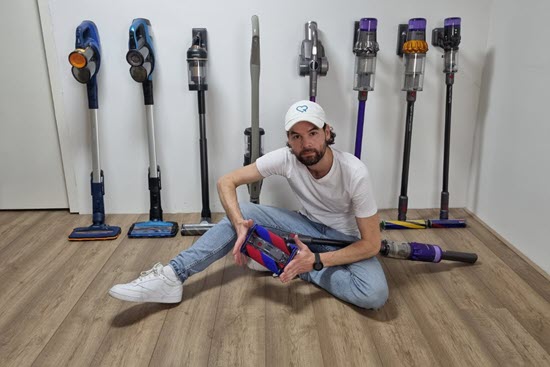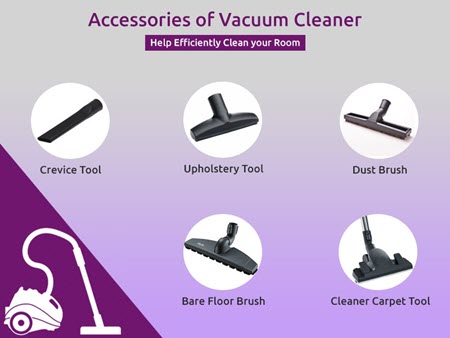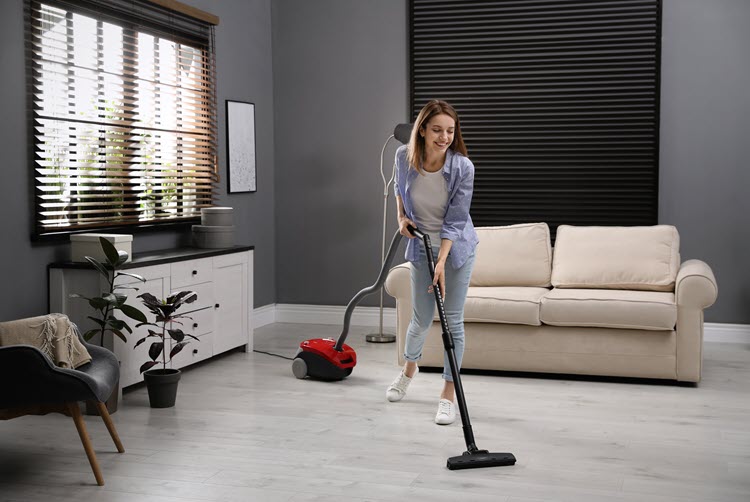Vacuuming does more than keep your floors looking clean. The cleanliness of your carpets also plays a role in your home’s air quality. Effective vacuuming eliminates dust, debris, and mites that contribute to allergies and asthma and helps reduce infection risks overall. How can you do an effective, efficient job of vacuuming your home? Learn the best steps to vacuum the floor, discover what tools you should use, and explore solutions to common vacuuming challenges through expert advice.
In This Article
How to Vacuum the Floor (the Right Way Every Time)
Let’s start with the basics. What is the most effective way to get a well-vacuumed floor?
- Dust first. Start from the top of the room and work your way towards the floor, using a damp microfiber cloth or cotton rag. After dusting, allow an hour for the dust in the air to settle before you vacuum.
- Inspect the floor. Make sure to pick up small debris like stray kitty litter, tiny Legos, or pine needles on the ground to clog or damage your vacuum.
- Clear the way. Move furniture and roll rugs up out of the way. It is a good idea to vacuum or beat your rugs when you clean your carpets.
- Start in the middle. Work your way out of the room towards an exit.
- Go slowly. Take your time to allow the vacuum’s beater bar or roller brush to agitate the carpet fibers. The most effective vacuuming happens while pulling, not pushing.
- Overlap your lines. Overlapping ensures you get the most dirt, dust, mites, and other gunk out of your carpets.
- Move in all four cardinal directions. Not only does this help fluff your carpet fibers, but it also prevents dirt from hiding beneath bent fibers.
- Be mindful of millwork. Move carefully to avoid banging into the baseboard around the edge of your rooms to prevent leaving marks and dings. Consider using the crevice tool to clean around the perimeter. It does a much better job of cleaning in tight corners.
- Empty at the halfway point. When your vacuum bag or canister is halfway full, stop and empty it. Vacuums lose efficiency at about 2/3 full.
- Use the right tools for the job. If you are vacuuming upholstery, furniture, tight corners, stairs, or vacuuming rugs, learn which tool is best for the job and use it.
- Be consistent. Set a regular schedule for cleaning to keep your floors maintained. You’ll end up with less work in the long run, and it will help extend the life of your carpets.
Why Should You Vacuum the Floor?
Aside from a clean floor, there are many benefits to regular vacuuming. In addition to removing dust and dirt that damages and degrades your carpet, vacuuming can help bring new life to the fibers and keep them looking plush longer. Plus, it helps improve your home’s air quality, removing dust, dirt, dust mites, mold spores, and bacteria that can trigger asthma, allergies, and other illness. It can even prevent bed bugs and other critters from making themselves at home.
What’s the Best Type of Vacuum for Floors?
The answer to this question will depend on your household’s unique needs. Ask yourself the following questions:
- Do you need to haul your vacuum up and down stairs? Weight is an essential factor if you’ll need to lift it regularly.
- Do you have pets that shed fur? Look for a pet-rated vacuum that can lift pet fur from carpet fibers.
- Do you have a lot of tight corners? You’ll want something easy to maneuver.
- Do you need to cover large rooms? You’ll either want a long-lasting battery or a longer cord.
- Do you want to use your vacuum to dust lampshades, curtains, or upholstered furniture? You’ll want to look for a vacuum with attachments to make those jobs easier.
- Do you or your household have dust allergies or asthma? You’ll want to look for vacuums with a HEPA filter that can attract and filter up to 99.7% of particles that reduce indoor air quality.
- Do you have to vacuum hard floors like concrete, laminate, hardwoods, or tile? Make sure roller brushes will not damage your floor. Some are better to sweep and mop. If your hardwood can handle the vacuum, look for one that is height adjustable. Also, check out our expert reviews on the best vacuums for laminate floors.
Once you know what features you need out of your vacuum, you can narrow down your search.
Floor Vacuums: What’s the Difference Between Stick, Upright and Handheld?
When it’s time to shop, it will be handy to understand the key differences between the typical household vacuums.
Stick Vacuums: These vacuums are lightweight, maneuver easily, and are particularly adept at keeping low-pile carpets and hard floors clean. Stick vacuums are best for those who do not need heavy suction power, like those with small children or pets that shed. Because they are smaller, their filter container also has a reduced capacity, so you’ll need to empty them more often.

Upright or Canister Vacuums: These vacuums weigh more and have more power. Upright or canister vacuums are best for those who need significant suction power, medium to deep pile carpets, pets that shed, or small children. They also tend to cover larger spaces more effectively.
Handheld Vacuums: These are small, cordless vacuums. Handheld vacuums are highly portable, making them an excellent choice for cleaning out a car, tackling steps, furniture, and car seats, or spot-cleaning unexpected messes.
A Breakdown of Common Vacuum Tools
Understanding the tools and accessories that come with your vacuum makes cleaning tasks more manageable. These are some of the most common attachments. Check with your manufacturer to see what comes included with yours.
- The Wand: Extends the reach of your accessories, so you don’t spend your cleaning time bent over.
- Upholstery Tool: This tool helps lift stuck fibers like hair and lint out of upholstered items and suction them up.
- Crevice Cleaner: The angled tip helps you access tight spaces like the baseboard edges, under and around appliances, door jambs, window frames, and car seat corners.
- Dusting Brush: This brush is best for lamp shades, trim, window treatments, and screens. The soft bristles prevent scratching and help dislodge dust.
- Floor Sweeper: Use over wood and tile to avoid damage from the vacuum’s motorized brushes and channel suction power to get up more dirt.
- Multi-Angle Brush: Maneuver this brush into tight spaces like closet tracks, light fixtures, crown molding, and blinds.
- Power Brush: Like a mini vacuum with a rotating brush to help tackle steps and other small carpeted spaces.
- Car Cleaning Nozzle: Looks somewhat like an ice scraper and keeps your car mats clean.
- Pet Groomer: An attachment that allows you to brush your critter with the vacuum hose without clogging up the brush with hair. If you do get a clog, here’s how you unclog your vacuum hose.
- Other attachments can include a drain unclogger to release blocked drains, a computer cleaner to dust your electronics, a radiator brush that fits over crevice tools, a mattress refresher, a fan blade duster, and more.

Frequently Asked Questions
You won’t damage your carpet if you want to do it daily. For high-traffic areas, vacuum at least twice a week. For the rest of your floors, once a week is sufficient.
Vacuuming is more effective at eliminating dirt and dust from your floors. In most cases, it’s better to vacuum instead of sweeping. If you have softwood floors, vacuuming may cause damage to the surface of the floor. Some tiled and laminate surfaces are also best avoided with the vacuum. You’ll want to use a dusting brush or sweep in those cases.
Should I Mop Before I Vacuum?
Vacuum before you mop. Vacuuming helps pick up loose dirt and debris. Cleaning those up beforehand makes mopping more efficient and produces better results.
Should I Dust or Vacuum First?
You should always dust first. Dusting leaves airborne particles behind. After about an hour, that dust will settle down on your floors and can then be vacuumed away.
Does Vacuuming Damage the Floor?
Most vacuums have a beater bar or roller brush to agitate carpet fibers. Vacuuming does insignificant damage to the fibers over time, but lingering dirt and dust do considerably more damage. It’s better to vacuum than to leave the dust where it lies.
Why Doesn’t My Vacuum Get My Floors Clean?
Your vacuum may need to be maintained. Ensure the hoses are not clogged, and the roller brush is free from hair and fibers. Keep the vacuum bag emptied before it reaches 3/4 full. If your vacuum has height adjusters, ensure it’s properly adjusted for the floor surface. Regularly replace or clean filters.
Final Word on Vacuuming Floors Properly
Put your favorite playlist on and give yourself the time you need to clean your floors. Start with dusting, work towards the floors, and go slow. Take care of your equipment, and it will take care of you. After these tips, you’ll be sure to have clean and well-maintained floors (and healthier air!)


